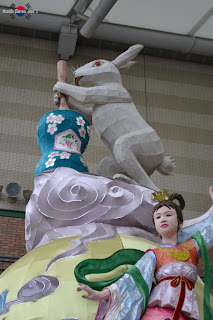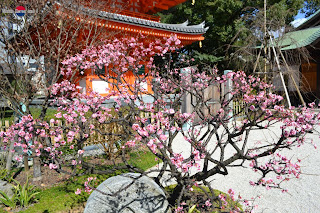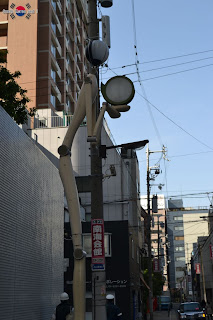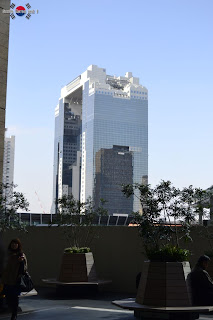o口(・∀・ ) ゴクゴク
So here is my post about the things we did in Fukuoka, which was the last city to stay at while being in Japan.
We arrived pretty late in Fukuoka and it was raining. Fukuoka was the only city where we stayed in a hotel, not a hostel. We had a very clean room with a lot of features like toothbrushes, Q-tips, hairbrushes, sponges, shoe polishing, etc... But it was soooooo small. I can only refer to it as "our corridor", because everything was packed together in a really small space. We could hardly open our suitcases. To do so we had to haul them up on the bed. But then the other person didn't really have space to move around.
Another disadvantage of the hotel was, that the contact with the staff was very distant. I don't really know how to describe it in English. The hostels' staff is always really good with English and they are eager to help you, they talk to you about what you did during the day and give you advice. In the hotel we asked for help at the reception. We wanted to make a reservation once or asked for a scale the other time. Their English wasn't really good and we had the impression we were the first persons to ask them for help, which didn't have to do with our stay at the hotel. They they weren't a great help either.
But we made a good bargain. We paid less than 20€ per person per night and got a good breakfast each morning.
On our first night in Fukuoka we walked down Nakasu island. This is where our hotel was. It's a small island between to rivers. You can find the famous Yatai stalls. Yatai are small, movable food stalls mostly selling Ramen (noodle soup), Oden and Yakitori (grilled chicken skewers). We had a good time there talking to people at our stall. In one stall fit about 10 to 15 people. There we met a American guy, who lives in Daejeon - the city I will stay at during my time in Korea. What a coincidence! He was very talkative and told us we found the best Ramen in Fukuoka. He always eats there when he travels to Japan every three months. The stall served Hakata-Ramen. It's a very rich soup made out of pork bones and they use special, very thin noodles. It's really good. You definitely have to try it when you are in the area or maybe they also sell it at the Ramen Museum in Yokohama.
Because the weather forecast was bad for the next day, we went on a day trip to Nagasaki. We were lucky. There was the Lantern Festival going on, which we didn't know about. Nagasaki is still influenced by the Chinese culture. The city has a Chinatown. A big area of the city was lit with beautiful lanterns. Not just the "normal" paper lanterns, but big installations made of paper and also one made of Chinese spoons and LEDs. Really really beautiful!
On this day we had Motsunabe (hot pot) for lunch. It was an adventure, because the waitress didn't speak any English and the Menu was Japanese as well. I managed to order and answer all her questions. The real challenge started when the food was there and we didn't really now what to put in the Nabepot and what was side dishes. I still don't know, but it was truly delicious! One of the best things I ate during our journey so far. We also got Mentaiko (fish roe), but we didn't like it that much. The Japanese like to use Mentaiko. I think it's probably better to eat it in a meal instead of "raw" like we did. Also I have to add that Motsunabe contains beef or pork guts. Ours were beef guts. When we ate it we didn't really know what kind of meat it is. But it tasted good, so what. I also like to eat chicken hearts. ^_~
If you have to possibility to try Motsunabe in Japan, do it!
We also visited some tourist spots in Nagasaki like the Museum of the atomic bomb, which hit Nagasaki during the Second World War, and the Peace Park. Unfortunately, we didn't have time to go to the observatory. Nagasaki's night view is supposed to be one of the three best in Japan. But that's just one more reason to go back there. But I have to say if you don't speak Japanese it will be a little hard on you. You can get around without problems. The basses have signs in English, but otherwise it's a bit challenging. It's the same in Fukuoka. You don't find as many English speaking people as in Tokyo, Kyoto or Osaka.
Now I remember, I also bought some Castalla. It's a sponge cake that's famous for Nagasaki. It was really good. It's a cake that's not to sweet and beautiful in it's simplicity. I also bought a small peach castella. But the icing was way to sweet :-(
The next day we did some sight seeing in Fukuoka. We went to some of the famous temples. Tochoji Temple for example is one of the oldest existing temples in Japan. The temple area contains a red five story pagoda and a really big wooden Buddah statue. We bought Ichigo Daifuku and went to Canal City. That's a big shopping complex, which contains a canal that runs through the whole complex. For those who want to know: you can find a Jump Shop, a Sanrio Shop and an NHK Shop at Canal City.
For a nice night view over Fukuoka we went to the Fukuoka Tower. This one also contains a lovers' sanctuary, where couples can leave locks with their names on it.
The next day was our last day in Japan. We went to a post office to send a package to my family in Germany. I almost managed to make the lady at the counter cry. I filled in the EMS form and brought my package to the counter. She then told me in very few English words that I have to give detailed information of what is inside the package. I have sent several packages from Japan to Germany before and always just wrote words like "sweets" or "kitchen tools". Now I had to tell her exactly what was inside (chocolate, potato chips, etc.). The problem was I didn't really know the English names of the kitchen tools inside so I just described one to her and didn't tell her about the others. I think at this time already 15 minutes had passed. She asked me two more times if I had told her everything, which was in the package. The she asked three of four times if the package contained batteries or lotions. And I'm not jocking she really repeated the same question again and again and my answer was always the same. She handed me my two press copies (out of the six ones available) and I thought everything was finally settled. About 25 minutes had passed. The last time it took me only 10 minutes to send the package. But then she handed me a piece of paper with the heading "invoice". On this paper I should have written down all the information that are already on the EMS form. I was confused. I didn't know what an invoice is and I never had to fill this in before. I asked her what this is. "An invoice". "Yes, I can read that, but what is an invoice? What's the purpose? The information is already on the EMS form."
She couldn't give me an answer and just stared at me. So I told her, that I had sent packages to Germany before many times and never had to fill this in. This was the first time. She just looked my in my eyes, repeating the words "first time?". I had the impression that she understood what I said, but wasn't able or willing to answer me in English. Until this moment I was really calm and polite. But at least 30 minutes had passed. I myself didn't notice it, but my boyfriend told me afterwards that my patience was wearing thin. So I kind of snapped a bit on her trying to explain again, that I never filled an invoice in before. After that she was really perplexed. I think she also had tears in her eyes, because at that moment I wondered if I had said something wrong. She just took the invoice from me and said it's okay. I asked "Now I don't need an invoice???" and she just nodded. Now I was confused and left the post office. When I researched the matter on the Internet later that evening, I saw that one must really fill in an invoice when sending packages from Japan to Germany with EMS. But I really never filled one in before and they always arrived in Germany. This particular package already arrived in Germany, too. I'm sorry post lady, but you really got on my nerves
( ̄へ ̄)
I was really upset about this matter, while going on to Fukuoka's Castle Ruins. Fukuoka once had a castle. But most of it was destroyed during the Second World War. You can walk the ruins and they even build a small museum where you can see how the castle could have looked before. This is definitely worth a visit. You have a nice view over the city from the highest point of the ruins. Also there is a big garden with Ume tress, which are starting to bloom.
The rest of the day we did what we did last time in Japan as well: doing nerd stuff. We went to game arcades, Madarake (a paradise for Anime & Manga interested people), etc.
{@TK: Yes, I bought some Doujin ;-) But there were some many I couldn't really decide which to buy.}
After that we went home early to get our stuff ready for the next day.
And that is the end of my Japan trip. The next day we got to the ferry port by taxi and left Japan with the JR Beetle ferry (not included for use with the JR Pass). The trip with the ferry was nice. You don't really notice the waves and it only takes 3 hours. I was sleeping at least 45 minutes. You can buy alcohol really cheap, because it's duty-free (n____n)
I will tell about our arrival in Korea in my next post. If you are one of my friends: I miss you guys. I hope you're fine!
Bye bye Japan! It was once again a really great time! (^ _ ^)/~~サヨナラ
 |
| Lanterns in front of a theater in Fukuoka |
 |
| Really big lantern at Nagasaki station |
 |
| Peace Park in Nagasaki |
 |
| Dragon at Nagasaki station |
 |
| Product of Nagasaki: Kakuni Manju |
 |
| Nagasaki Station |
 |
| Nagasaki Lantern Festival |
 |
| Big wooden Buddah at Tochoji Temple |
 |
| Pagoda at at Tochoji Temple |
 |
| Ume (?) at Tochoji Temple |
 |
| Canal City |
 |
| Fukuoka Tower |
 |
| Fukuoka Castle Ruins Museum |
 |
| Night view over Fukuoka |
 |
| Ume tree at Fukuoka's Castle Ruins |
 |
| Ohori Park in Fukuoka |
 |
| Plum tree at Fukuoka's Castle Ruins |
 |
| At Ohori Park |


















































